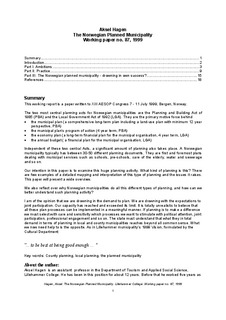| dc.description.abstract | This working report is a paper written to XIII AESOP Congress 7 - 11 July 1999, Bergen, Norway.
The two most central planning acts for Norwegian municipalities are the Planning and Building Act of 1985 (PBA) and the Local Government Act of 1992 (LGA). They are the primary motive force behind the municipal plan (a comprehensive-long-term plan including a land-use plan with minimum 12 year
perspective, PBA), the municipal plan’s program of action (4 year term, PBA), the economy plan (a long-term financial plan for the municipal organisation, 4 year term, LGA), the annual budget ( a financial plan for the municipal organisation, LGA). Independent of these two central Acts, a significant amount of planning also takes place. A Norwegian municipality typically has between 30-50 different planning documents. They are first and foremost plans dealing with municipal services such as schools, pre-schools, care of the elderly, water and sewerage and so on.
Our intention in this paper is to examine this huge planning activity. What kind of planning is this? There are few examples of a detailed mapping and interpretation of this type of planning and the issues it raises. This paper will present a wide overview. We also reflect over why Norwegian municipalities do all this different types of planning, and how can we better understand such planning activity?
I am of the opinion that we are drowning in the demand to plan. We are drowning with the expectations to joint participation. Our capacity has reached and exceeded its limit. It is totally unrealistic to believe that all these plan processes can be implemented in a meaningful manner. If planning is to make a difference we must select with care and sensitivity which processes we want to stimulate with political attention, joint participation, professional engagement and so on. The state must understand that what they in total demand in terms of planning in local and county municipalities reaches beyond all common sense. What we now need help to is the opposite. As in Lillehammer municipality´s 1999 Vision, formulated by the Cultural Department: "... to be best at being good enough … “ | en |
